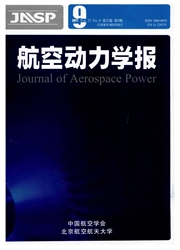

 中文摘要:
中文摘要:
从纳秒脉冲等离子体气动激励对流场的作用机理出发,将其对流场的作用等效为热源对流场的快速加热,建立了纳秒脉冲等离子体气动激励的空气动力学模型.应用模型计算了单次纳秒脉冲等离子体气动激励下静止流场的响应,计算结果表明:纳秒脉冲等离子体气动激励可在静止流场中形成一个高温升压升区(716K,225.95 kPa)和一个低温升压升区(380K,131.7kPa),分别可诱导一强一弱两道压缩波,压缩波后各有一道稀疏波.压缩波与稀疏波同速向外传播,传播速度开始较大(大于400m/s),随着逐渐向外传播,其传播速度逐渐减小(357 m/s).压缩波经过的区域可诱导局部速度,初期诱导的局部速度较大,在激励器切向和法向可诱导60m/s以上的局部速度,随着压缩波的衰减,诱导局部速度的能力减弱,最大可诱导10m/s左右的局部速度.
 英文摘要:
英文摘要:
A nanosecond pulse plasma aerodynamic actuation kinetic model was presen- ted based on its effect on flow field mechanism. The effect of nanosecond pulse plasma aero- dynamic actuation on flow field was represented by fast heating of thermal source. Simula- tive investigation of one nanosecond pulse was performed under static flow field conditions. The simulation results show that the temperature and pressure rise abruptly in the narrow space in static flow field by nanosecond pulse plasma aerodynamic actuation. One zone is high (716K, 225.95kPa) and the other one is relatively low (380K, 131.7kPa). They in- duce a strong compressional wave and a weak compressional wave following strong and weak rarefaction waves respectively. The compressional wave and rarefaction wave propagate to the far field at a high speed (above 400m/s) and then the speed reduces soon (357m/s). Lo- cal speed is induced when the compressional wave passes by. The maximum induced local speeds in the normal and tangential directions of actuator are above 60 m/s at beginning and soon reduce to about 10 m/s with the reduction of compressional wave.
 同期刊论文项目
同期刊论文项目
 同项目期刊论文
同项目期刊论文
 期刊信息
期刊信息
